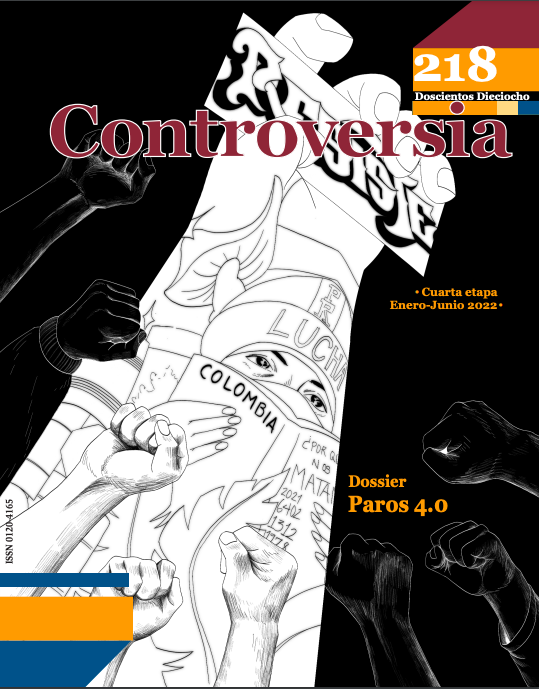Abstract
This article argues that the latest social movements cannot be exclusively understood as “next generation” movements with their multifaceted digital forms. Without denying the social, emotional and political impact of the new information and communication technologies, it is necessary to understand to what extent these movements are rooted in —and are faced by— materialities, artifacts and networks with a long historical trajectory. Through four sections, in the manner of “displacements”, the article delves into the permeability between the digital and the material world, on the one hand, and between the civil and the military sphere, on the other. Drawing on fresh approaches from the history and sociology of technology, the authors aim to contribute with some “emergency thoughts” to think about the entanglement between technology, politics and violence in the latest protests in the streets of Colombia.

This work is licensed under a Creative Commons Attribution-NonCommercial 4.0 International License.
References
Aragón, Ferran; Sastre, Jaume y Valentines, Jaume. (2021). Concertinas en la Europa Fortaleza. Tecnologías, fronteras y control del espacio. En José Ramón Bertomeu (Ed.). Saberes en Acción. https://sabersenaccio.iec.cat/es/concertinas-en-la-europa-fortaleza
Arendt, Hannah. (2015). Sobre la violencia. Alianza.
Basalla, George. (1991). La evolución de la tecnología. Crítica.
Benjamin, Ruha. (2019). Race after technology: Abolitionist tools for the New Jim Code. Polity Press.
Bucher, Taina. (2018). If ... Then: Algorithmic power and politics. Oxford University Press.
Castells, Manuel. (2002). La galaxia Internet. Plaza & Janés.
Castells, Manuel. (2012). Redes de indignación y esperanza. Los movimientos sociales en la era de Internet. Alianza.
Chun, Wendy Hui Kyong. (2006). Control and Freedom. Power and Paranoia in the Age of Fiber Optics. MIT Press.
Davis, Mike. (2017). Buda's Wagon. A Brief History of the Car Bomb. Verso.
Duperrex, Matthieu y Le Meur, Mikaëla (Eds.). (2020). Semer le trouble. Soulèvement, subversions, refuges. Techniques & Culture, (74), 1-222.
Edgerton, David. (2007). Innovación y tradición. Historia de la tecnología moderna. Crítica.
Farrell, Henry y Newman, Abraham. (2021). Of Privacy and Power. The Transatlantic Struggle over Freedom and Security. Princeton University Press.
Feigenbaum, Anna. (2017). Tear Gas. From the Battlefields of World War1 to the Streets of Today. Verso.
Fridlund, Mats. (2011). Buckets, Bollards and Bombs: Towards Subject Histories of Technologies and Terrors. History and Technology, 27(4), 391-416.
Gabrys, Jennifer. (2013). Digital Rubbish. A Natural History of Electronics. University of Michigan Press.
Goodman, Steve. (2009). Sonic Warfare: Sound, Affect, and the Ecology of Fear. MIT Press.
Goodwin, Jeff; Jasper, James y Polletta, Francesca (Eds.). (2001). Passionate Politics: Emotions and Social Movements. University of Chicago Press.
Grupo de Afinidad Quico Rivas. (2009). La Barcelona de la dinamita, el plomo y el petróleo. 1884-1909. (Apuntes para un recuento final de cadáveres). Grupo de Afinidad Quico Rivas.
Gusterson, Hugh. (2004). People of the bomb. Portraits of America’s Nuclear Complex. University of Minnesota Press.
Gusterson, Hugh. (2016). Drone: Remote Control Warfare. MIT Press.
Hache, Alex (Ed.). (2014). Souveraineté technologique. Ritimo.
Han, Byung-Chul. (2013). La sociedad de la transparencia. Herder.
Hazan, Eric. (2015). A History of the Barricade. Verso.
Hughes, Thomas. (1998). Rescuing Prometheus. Pantheon Books.
Ippolita. (2012). En el acuario de Facebook: el resistible ascenso del anarco-capitalismo. Enclave de Libros.
Ippolita. (2017). Tecnologie del dominio. Lessico minimo di autodifesa digitale. Meltemi.
Juris, Jeffrey; Pereira, Inés y Feixa, Carles. (2012). La globalización alternativa y los ‘novísimos’ movimientos sociales. Revista del Centro de Investigación Universidad La Salle, 10(37), 23-39.
Kranzberg, Melvin. (1986). Technology and History: "Kranzberg's Laws". Technology and Culture, 27(3), 544-560.
Lotan, Gilad; Graeff, Erhardt; Ananny, Mike; Gaffney, Devin; Pearce, Ian y Boyd, Danah. (2011). The Revolutions Were Tweeted: Information Flows During the 2011 Tunisian and Egyptian Revolutions. International Journal of Communication, (5), 1375-1405.
MacKenzie, Donald y Wajcman, Judy (Eds.). (1999). The Social Shaping of Technology. Open University Press.
Mavhunga, Clapperton Chakanetsa. (2011). A Plundering Tiger with Its Deadly Cubs? The USSR and China as Weapons in the Engineering of a Zimbabwean Nation, 1945-2009. En Gabrielle Hecht (Ed.). Entangled Geographies. Empire and Technopolitics in the Global Cold War (pp. 231-266). MIT Press.
Medina, Eden; Marques, Ivan Da Costa y Holmes, Christina (Eds.). (2012). Beyond Imported Magic. Essays on Science, Technology, and Society in Latin America. MIT Press.
Miller, Henry. (1972). Reflections on the Death of Mishima. Capra Press.
Misa, Thomas. (2004). Leonardo to the Internet: Technology and Culture from the Renaissance to the Present. Johns Hopkins University Press.
Noble, David. (1977). America by Design: Science, Technology and the Rise of Corporate Capitalism. Alfred A. Knopf.
Nye, David. (2010). When the Lights Went Out. A History of Blackouts in America. MIT Press.
O’Neil, Cathy. (2016). Weapons of Math Destruction: How Big Data Increases Inequality and Threatens Democracy. Broadway Books.
Pais, Fernando Eduardo da Silva. (1938). As forças de segurança na defesa passiva das grandes cidades. [Centro Tipográfico Colonial].
Pouget, Émile. (1911). Le Sabotage. M. Rivière.
Sandoval, Laila Y. (2017). La desaparición del combate clásico: un nuevo tipo de guerra. La sustitución del combatiente por el dron. En María Gajate y Laura González (Eds.). Guerra y Tecnología. Interacción desde la Antigüedad al presente (pp. 531-575). Fundación Ramón Areces.
Sastre-Juan, Jaume y Valentines-Álvarez, Jaume. (2014). Innovació tecnològica i canvi social al segle XX. Guia docent. Universitat Oberta de Catalunya.
Sastre-Juan, Jaume y Valentines-Álvarez, Jaume (Eds.). (2019). Fun and Fear: The Banalization of Nuclear Technologies Through Display. Centaurus, 61(1-2), 2-90.
Scott, James. (1998). Seeing Like the State: How Certain Schemes to Improve the Human Condition Have Failed. Yale University Press.
Sean, Cubitt. (2017). Finite Media: Environmental Implications of Digital Technologies. Duke University Press.
Shifman, Limor. (2014). Memes in Digital Culture. MIT Press.
Tastevin, Yann Philippe. (2020). Le pneu au piquet. Techniques & Culture, (74). 84-85.
Tay, Geniesa. (2012). Embracing LOLitics: Popular Culture, Online Political Humor, and Play [MA thesis, University of Canterbury]. https://ir.canterbury.ac.nz/handle/10092/7091
Tilly, Charles. (2006). Regimes and Repertoires. University of Chicago Press.
Traugott, Mark. (2010). The Insurgent Barricade. University of California Press.
Tufekci, Zeinep. (2017). Twitter and Tear Gas: The Power and Fragility of Networked Protest. Yale University Press.
Valentines-Álvarez, Jaume y Macaya, Ana. (2019). Making fun of the atom: Humour and pleasant forms of anti-nuclear resistance in the Iberian Peninsula, 1974-1984. Centaurus. Journal of the European Society for the History of Science, 61(1-2), 70-90.
Valentines-Álvarez, Jaume. (2017). Objectivo Cahora Bassa: Violência e tecnologia na guerra colonial em Moçambique, 1966-1974. Seminario de la Serie “Ciência e Império”, ICS, Lisboa, octubre.
Viñas, Ángel. (2017). El rostro cambiante de la guerra. En María Gajate y Laura González, (Eds.). Guerra y tecnología. Interacción desde la Antigüedad al presente (pp. 35-54). Centro de Estudios Ramón Areces.
Wajcman, Judy. (2006). El tecnofeminismo. Cátedra.
Winner, Langdon. (1986). The Whale and the Reactor. A Search for Limits in an Age of High Technology. University of Chicago Press.
Wolfsfeld, Gadi; Sheafer, Tamir & Segev, Elad. (2013). Social Media and the Arab Spring: Politics Comes First. The International Journal of Press/Politics, 18(2), 115-137.
Access Now. (3 de marzo de 2021). Sueños rotos y oportunidades perdidas: un año en la lucha por #KeepItOn [Internet shutdowns report]. https://www.accessnow.org/keepiton-informe-un-ano-en-la-lucha
Alimonti, Veridiana. (24 de diciembre de 2019). Protestas y tecnología en América Latina: Un balance sobre el 2019. Electronic Frontier Foundation. https://www.eff.org/es/deeplinks/2019/12/protests-and-technology-latin-america-2019-review-0
Amnistía Internacional. (11 de junio de 2020). Mientras continúan las protestas en todo el mundo, la tecnología de reconocimiento facial debe prohibirse. Noticias Amnistía Internacional. https://www.amnesty.org/es/latest/news/2020/06/usa-facial-recognition-ban
Amnesty International. (Enero de 2021). Tear gas: An investigation [con mapa de productores e incidencias]. https://teargas.amnesty.org
Calderó, Clara; Franquesa, Anaïs; García, Andrés; Medina, Laura; Santiago, Irene; Urango, Irene y Vigara, Serlinda. (2021). Stop Balas de Goma. Informe sobre el empleo e impactos de las balas de goma en el Estado español desde un enfoque de derechos humanos (2000-2020). NovaAct /Irídia.
Centre Delàs d'Estudis per la Pau. (2020). Exportaciones españolas de productos y tecnologías de doble uso / de material antidisturbios (2004-2020). http://database.centredelas.org/exportacio-armes/3/ http://database.centredelas.org/exportacion-armas/6
Derechos digitales. (18 de noviembre de 2019). Informe de Derechos Digitales a organismos internacionales de DDHH. Situación de derechos humanos y el uso de tecnología en el contexto de la protesta social en Chile 2019. https://www.derechosdigitales.org/wp-content/uploads/DD-Reporte-DDHH-Chile-2019.pdf
Edgerton, David. (19 de junio de 2017). Digital Transformation. Entrevista con Manuel Stagars. Youtube. https://www.youtube.com/watch?v=bnD3CjrMcm8 [Archivo de video]
El Escarbabajo de Cuestión Pública, Redacción. (2 de junio de 2021). Los millonarios contratos de armas “no letales” para la Policía y el Esmad. Cuestión Pública. https://cuestionpublica.com/los-millonarios-contratos-de-armas-no-letales-para-la-policia-y-el-esmad
El Espectador. (5 de mayo de 2021). Venom: el arma en la tanqueta del Esmad, que causó pánico en el sur de Bogotá, en el Paro Nacional. El Espectador. https://www.elespectador.com/bogota/venom-el-arma-en-la-tanqueta-del-esmad-que-causo-panico-en-el-sur-de-bogota-en-el-paro-nacional-article/
Fundación para la Libertad de Prensa [FLIP]. (29 de octubre de 2021). Los jueces de la verdad, el mar de mentiras detrás del ciberpatrullaje del Estado. https://flip.org.co/index.php/es/informacion/pronunciamientos/item/2817-los-jueces-de-la-verdad-el-mar-de-mentiras-detras-del-ciberpatrullaje-del-estado
Lanza, Edison. (2019). Protesta y Derechos Humanos. Estándares sobre los derechos involucrados en la protesta social y las obligaciones que deben guiar la respuesta estatal. Organización de los Estados Americanos.
Mehrotra, Kartikay. (15 de julio de 2021). Citizen Lab: Spyware by Israel’s Candiru used to target activists. Aljazeera News. https://www.aljazeera.com/economy/2021/7/15/citizen-lab-spyware-by-israels-candiru-used-to-target-activists
Muñoz Ramírez, Gloria. (31 de diciembre de 2013). Entrevista con el subcomandante Marcos. desInformémonos. https://desinformemonos.org/entrevista-inedita-subcomandante-marcos-origen-balance-guerra-1994/
Peña, Andrés y Rivero, Gustavo. (19 de mayo de 2021). K-pop y paro nacional: transparencia sí, pero no así. El Espectador. https://www.elespectador.com/mundo/mas-paises/k-pop-y-paro-nacional-transparencia-si-pero-no-asi-article/
Rachman, Gideon; Mander, Benedict; Dombey, Daniel; Lin, Sue y Saleh, Heba. (11 de noviembre de 2019). La tecnología cambia la forma de protestar. https://www.expansion.com/economia-digital/innovacion/2019/11/11/5dc86c81e5fdeaf8448b46b6.html
Stockholm International Peace Research Institute [SIPRI]. (15 de marzo de 2021). SIPRI Arms Transfers Database. https://www.sipri.org/databases/armstransfers
Temblores e Indepaz. (17 de mayo de 2021). Informe de Temblores ONG e Indepaz a la CIDH sobre la violación sistemática de la Convención Americana y los alcances jurisprudenciales de la Corte IDH con respecto al uso de la fuerza pública contra la sociedad civil en Colombia en el marco de las protestas realizadas entre el 28 de abril y el 12 de mayo de 2021. http://www.indepaz.org.co/informe-de-temblores-ong-e-indepaz-a-la-cidh
W Radio. (18 de mayo de 2021) Los tres polémicos procesos de contratación que adelanta la Policía Nacional. https://www.wradio.com.co/noticias/actualidad/los-tres-polemicos-procesos-de-contratacion-que-adelanta-la-policia-nacional/20210518/nota/4135691.aspx



